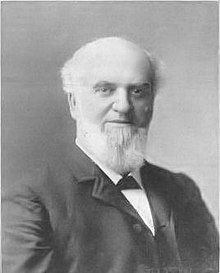Lewis Miller | |
|---|---|
 | |
| Born | (1829-12-13)December 13, 1829 Greentown, Ohio, US |
| Died | February 17, 1899(1899-02-17) (aged 69) New York City, US |
| Occupation(s) | Inventor and industrialist |
| Employer(s) | C. Aultman & Co. Aultman, Miller & Co. Buckeye Mower & Reaper Co. |
| Known for | Inventor of Buckeye Mower (1855), Akron Plan architecture for Sunday school buildings (1867), co-founder of the Chautauqua Assembly (1874), philanthropy |
| Title | Partner, Superintendent, and President (c. 1892) |
| Political party | Greenback candidate for Congress (1878) |
| Spouse |
Mary Valinda Alexander
(m. 1852) |
| Relatives | Thomas Edison (son-in-law) Emily Huntington Miller (sister-in-law) Charles Edison (grandson) Theodore Miller Edison (grandson) |
| Signature | |
Lewis Miller (July 24, 1829 – February 17, 1899) was an American businessman and philanthropist who made a fortune in the late 19th century as inventor of the first combine (harvester-reaper machine) with the blade mounted efficiently in front of the driver, to the side of the horse(s), rather than pulled behind. His daughter Mina (1865–1947) married fellow Ohio inventor Thomas Alva Edison on February 24, 1886.